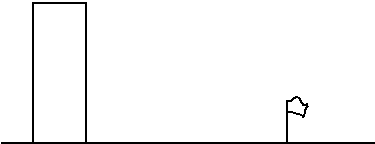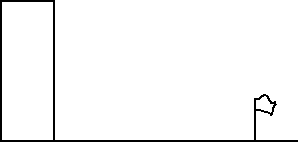Use a proportion to find the part.15% of 15 is what number?
Solving Proportions: The Dominicus's Rays & "Parts"
A very common grade of "proportions" exercise is that of finding the height of something very tall past using the daytime shadow length of that same thing, its shadow being measured horizontally along the ground. In such an practice, nosotros utilise the known height of something shorter, along with the length of that shorter affair's daytime shadow as measured at the same time.
This process will of course only work if the ground is perfectly apartment but, under that supposition, the reasoning is valid. The sun is far enough away that the rays of light that attain one general area on the planet (say, a particular parking lot) may safely be regarded equally being parallel.
Content Continues Beneath
This manifestly would not be the instance for a nearby light-source, such as a helicoptor hovering overhead:


As you can see above, the low-cal rays from the chopper's spotlight, with respect to the edge of the topmost role of the edifice and the top of the flagpole in the parking lot, are not even shut to beingness parallel.
On the other hand, as you lot can see below, the sun'southward rays in the same general area volition exist close enough to being parallel as makes no divergence:


To excerpt the intended and necessary data from the above film, we draw an horizontal line for the ground, vertical lines for the heights of the edifice and the flagpole, and slanty lines indicating the sun'southward rays. (An animation in the exercise beneath illustrates this process.)
Because the slanty lines are assumed to be at the same angle from the horizontal, so these two triangles must be like. Then we can apply what yous know near proportions and similar figures to solve the exercise.
Notation that, because the height-lines and the ground are (assumed to be) perpendicular, the similar triangles are also right-angled triangles. This doesn't ordinarily affair, but try to make the triangles that you draw await at least roughly correct-angled.
Exercises involving the dominicus'southward rays commonly inquire for the heights of buildings, very tall trees, or oversized flag poles; and y'all're expected to determine these heights based on known information from short copse, curt poles, or something as elementary equally a measuring stick stood on finish, perfectly vertically, on the pavement, or maybe your own shadow.
-
A building casts a 103-foot shadow at the same time that a 32-foot flagpole casts every bit 34.five-human foot shadow. How alpine is the building? (Round your answer to the nearest tenth.)
This exercise involves a tall edifice, a shorter flagpole (of known height), and the shadows cast by each of the edifice and the pole. I am expected to assume that the basis on which the building and the flagpole are situated is perfectly flat, at least in the areas on which their shadows are cast. And I'k expected to use the fact that the sunday's rays are, in applied terms, parallel. In other words, I'm supposed to have this picture in listen:


This gives me two similar (and right) triangles. The to a higher place image explains how the triangles are derived; the below paradigm shows the pertinent data that I've abstracted from the exercise, and is the information that I'll employ to answer the question:

Because the triangles are similar, I can gear up a proportion and solve for the elevation h :
I'll use the shortcut method:
![]()
Rounding to the nearest tenth, and adding on the right units, I find that the building has a top of almost:
95.5 anxiety
-
Yous're concerned that your neighbor'due south backyard flagpole may autumn over in heavy winds (it looked really wobbly during the last thunderstorm), and you're hoping information technology doesn't fall over and hit your business firm. One afternoon, you notice that the iv-pes loftier chain-link argue is casting a shadow seven feet long, while the neighbor's pole is casting a shadow 26 feet long. The base of the pole is 18 feet from your house. Is your house safe?
This is a pretty direct-forrard awarding of using the sun's rays to judge top. I'll set up my proportion, and solve:
The pole is close to, but certainly no more than than, fifteen feet in summit. (This is a common residential maximum.) As long as the pole isn't sent flying, and only falls over in the adjacent storm:
the house is safe
-
Will is heading out to his car. He notices a tall pine tree whose shadow, from base to tip (and parallel to the parking lot), is currently the length of 2 parking spaces, each of which is two.75 meters wide. Will is 178 cm tall, and he notices that, with his back to the sun, his shadow extends exactly one shoe-length length past the finish of his anxiety. When he gets home, he finds that his shoes are 33 cm long. How tall is the tree? (Circular to the nearest half-meter.)
If the sunday had been directly above Will, so his shadow would have puddled on his shoes. Instead, his shadow was projected forrad, so I have useful sun's rays. I'll count the part of his shadow that was projected in front of his anxiety.
Each parking space is 2.75 meters wide, and so the tree's shadow is 5.5 meters long. Will's shadow is 33 cm long, and his top is 178 cm. I'll represent the tree's height past h , and ready my proportion:
The unit for the tree is meters, and I'm supposed to round to the nearest one-half-meter. Since 29.666... is closer to 29.5 than to xxx.0, my answer is that the tree'south top is about:
29.5 meters
"Parts"
There is ane last type of problem that yous may not even think of as being a "ratios and proportions" kind of problem, just it arises often in "real life".
Sometimes, when you are mixing something (such every bit "mixed drinks", animate being feeds, children'south play-clay, potting soil, or color dyes), the measurements are given in terms of "parts", rather than in terms of so many cups or gallons or milliliters. For instance:
-
The instructions for mixing a certain type of physical telephone call for 1 part cement, ii parts sand, and 3 parts gravel. (The amount of water to add will vary, of class, with the wetness of the sand existence used, and will be determined on-site.) You have iv cubic feet of sand. How much cement and gravel should you mix with this sand?
Since the sand is measured in cubic feet and the "recipe" is given in terms of "parts", I will permit "one cubic foot" exist "one part".
The ratio of cement to sand is i : 2, and I take four cubic feet of sand. I will ascertain " c " to stand for the corporeality of cement that I need, and I will gear up upwardly and solve my proportion.
I'd better not forget my units! The respond to my equation is "2", but the reply to this role of the do is that I need "two cubic feet of cement".
Now I'll solve for the amount of gravel to add. The ratio of sand to gravel is 2 : 3, and I have four cubic feet of sand. I will define " one thousand " to stand up for the amount of gravel that I need, and I volition fix and solve my proportion:
Keeping the context in mind, the answer to my equation is " k = half dozen", but the answer to this part of the exercise is that I need "half dozen cubic feet of gravel". Then my consummate answer is:
two cubic feet of cement
half dozen cubic feet of gravel
-
A particular liquid-cleanser concentrate says to dilute information technology past combining one part concentrate with 32 parts water. Your spray bottle's superlative "make full" line says "946 mL". How much concentrate should yous pour into the bottle? (You'll so add water upwards to the fill line.) Circular to the nearest whole number.
My "parts" are the concentrate and the h2o. The bottle only gives me a total volume, so I'll demand to utilise the total number of parts. The total number of parts is 1 + 32 = 33. I'll set up my proportion with the concentrate (which is what they want) and the total (which is what I know):
Rounding downwardly to the nearest whole milliliter of the concentrate, I should cascade in:
29 mL
mendezdebectiand75.blogspot.com
Source: https://www.purplemath.com/modules/ratio7.htm
0 Response to "Use a proportion to find the part.15% of 15 is what number?"
Post a Comment